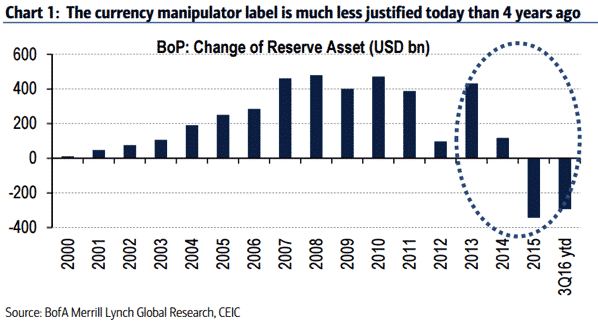Monetary offset, the strong dollar and China’s currency manipulation
With the Fed talking up the likelihood of three rate hikes in 2017 while other central banks are still in easing mode, the potential for a US dollar rout and a concomitant closing of the US trade deficit is pretty low. Therefore, given Donald Trump’s hawkish rhetoric on China, the potential that the US government labels China a currency manipulator for the first time since 1994 is high.
Let’s start this post with two public performances by Fed chair Janet Yellen and my explanation of what they mean for the economy.
The first was in December as the FOMC hiked rates for just the second time in a decade. At the press conference afterwards, Yellen was asked about comments she had made in October about allowing the economy to run hot and what those comments meant for monetary policy, jobs, and wages. In the October speech Yellen said the following:
If we assume that hysteresis is in fact present to some degree after deep recessions, the natural next question is to ask whether it might be possible to reverse these adverse supply-side effects by temporarily running a “high-pressure economy,” with robust aggregate demand and a tight labor market. One can certainly identify plausible ways in which this might occur…
[…]
More research is needed, however, to better understand the influence of movements in aggregate demand on aggregate supply.
Translation: after an awful recession like the one we had from 2007 to 2009, there are lingering negative effects that retard job growth. Economists call it hysteresis. Some economists suggest you might let the labor market get so tight that the economy overshoots on wage growth and on inflation, in order to counteract the effects of hysteresis. But this is just theory. I’m not sure we want to let this happen.
Now when asked about these comments in December, Yellen basically disavowed thinking about running a ‘high-pressure” economy. She said it was a theoretical question that had no impact on actual Fed policy.
So that’s the first performance. And in that performance Yellen basically said the Fed needs to tighten monetary policy if and when the economy nears full employment in order to ‘pre-empt’ inflation.
Now the second Yellen performance was 5 days later at a graduation speech at the University of Baltimore. Here’s what she said that needs highlighting:
..you are entering the strongest job market in nearly a decade. The unemployment rate, at 4.6 percent, is near what it was before the recession…
Challenges do remain…
But it also looks like the economic gains of the past few years are finally raising living standards for most people…Those who graduate and enter the workforce during a strong economy are more likely to find employment, remain employed, and enjoy persistently higher earnings.
Translation: the economy is near full employment. Yeah, there is still some work to be done. But you guys are entering the labor market at a pretty good time.
If you put these two performances together it says pretty unequivocally that Yellen a. thinks the US labor market is about as tight as it can get without inflation becoming a problem and b. that the Fed needs to act pre-emptively now to make sure inflation doesn’t rear its ugly head in a way that forces the Fed into tightening aggressively – and provoking a recession. That’s what she’s saying and the rationale behind it.
I agree with neither the assessment nor the rationale. But that doesn’t matter because it’s Yellen who chairs the FOMC. And she’s saying pretty decisively that the Fed is ready to hike more.
So regardless of what a Donald Trump administration wants to do regarding fiscal policy, the Fed stands ready to pursue its dual mandate — and that means monetary policy will offset anything that comes out of the Trump administration. So if Trump wants to add fiscal stimulus, it won’t matter because of the Fed’s pre-emptive view on inflation and Yellen’s view we are near full employment; the Fed will be forced to raise rates even faster than it has said it will do.
Higher rates mean a stronger dollar. And a stronger dollar means a larger trade deficit and downward pressure on the Chinese Yuan. Now the Chinese are already hemorrhaging foreign currency reserves to prevent capital flight and to counteract Chinese corporate borrowers who are busy buying US dollars to pay down dollar-denominated debt. See the chart below:

Now Bank of America will tell you the currency manipulator label really isn’t a good one for China these days. And even Trump chief economic advisor Gary Cohn said point blank last year that he thinks the Chinese will need to devalue:
“The Chinese have taken multi-decade views on what they’re doing. They built up their surplus capital account over many, many years. It is going down. It is undeniably going down, and you can see it in the numbers. They may take some actions in the next few months to deal with that. You know, look, so I believe that they’re going to end up devaluing the currency? I do believe they will end up devaluing the currency.”
So how is China manipulating its currency except to prop it up? Does this even matter?
Bank of America’s Helen Qiao says:
“The main point of naming China as a currency manipulator would be to bring China back to the negotiation table at the lowest cost,”
So we should fully anticipate that China will make the list of currency manipulators in 2017. And if they do, the ball will in Chna’s court to come to the negotiating table or up the ante in a burgeoning trade war.
Comments are closed.